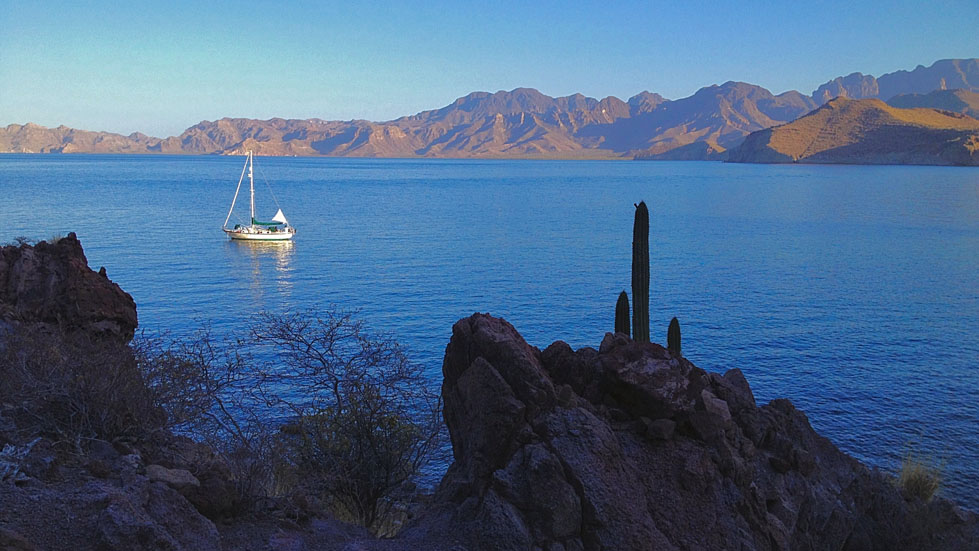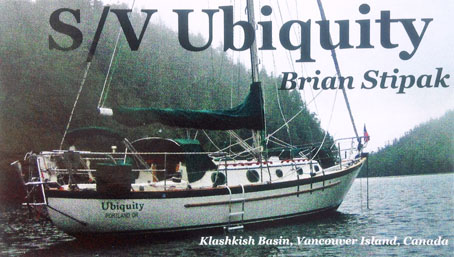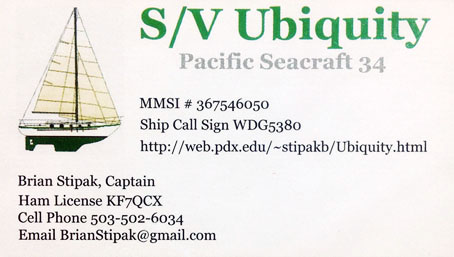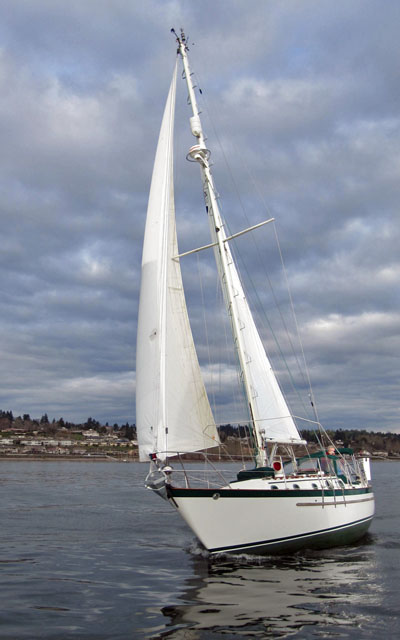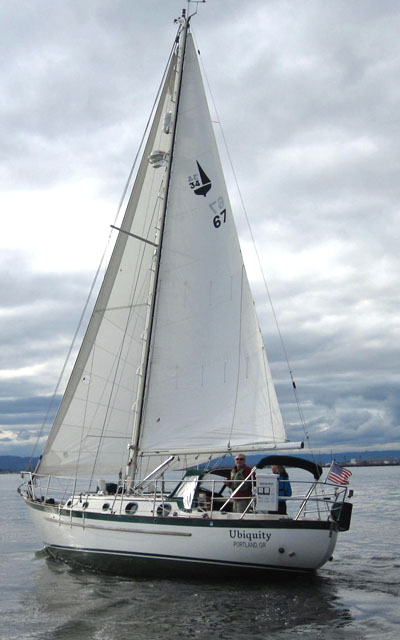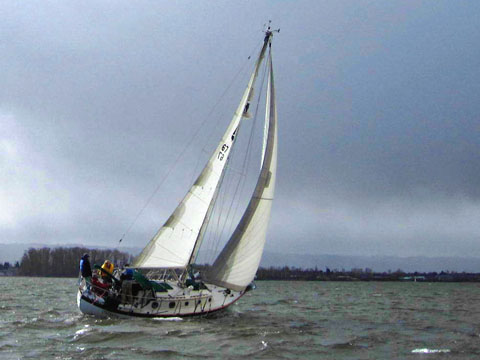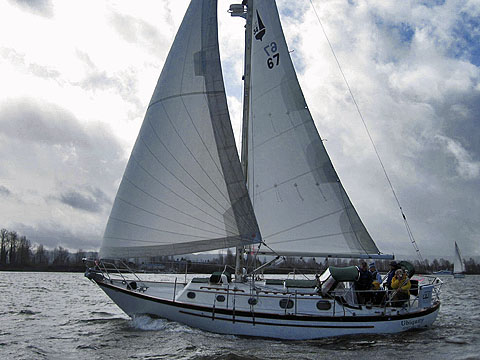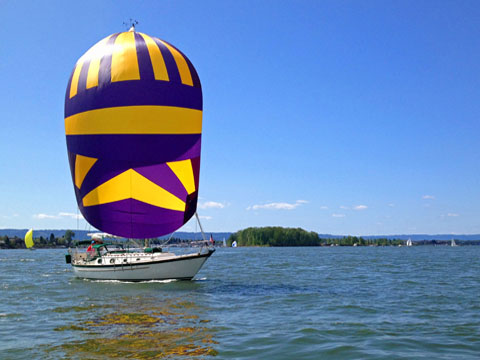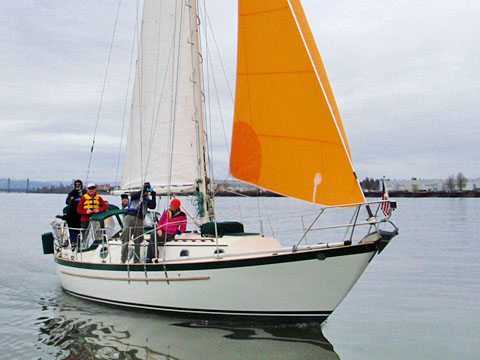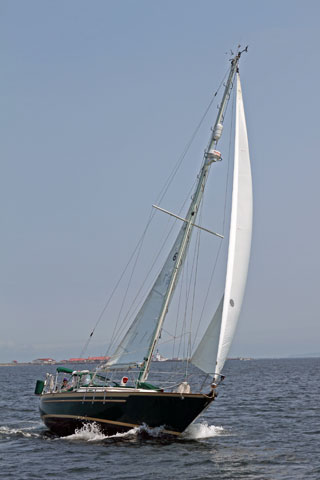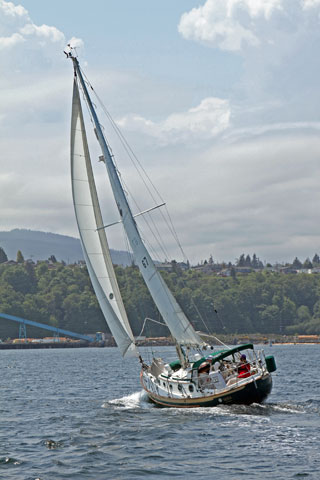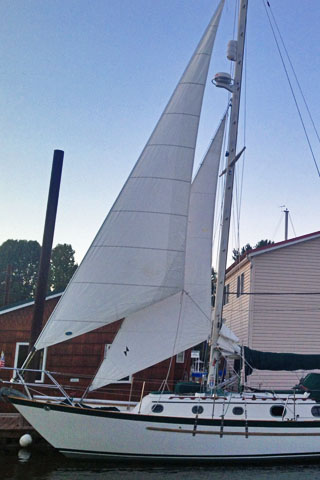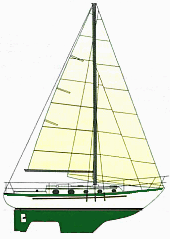 |
Pacific Seacraft 34 Sailboat
The Pacific Seacraft 34, also called the "Crealock 34",
was Bill Crealock's design for a slightly smaller and updated
version of his classic cruising sailboat, the Pacific Seacraft 37.
Pacific Seacraft Corporation's sales brochure called her a "refined sibling",
a "slightly smaller sister".
Dave Mancini reports that in a conversation he was privileged to have with
Bill Crealock, Crealock discussed what he had learned from the 37 design that he used
to refine the 34 design.
Crealock described his goals for these cruising designs as
"an easy motion, dryness, strength, windward ability, a comfortable deep cockpit,
a safe interior and, above all, ease of handling and balance with or without steering aids".
|
A Pacific Seacraft 34 sailboat
at anchor in Klashkish Basin, Vancouver Island, Canada,
waiting to round the notorious Brooks Pennisula:
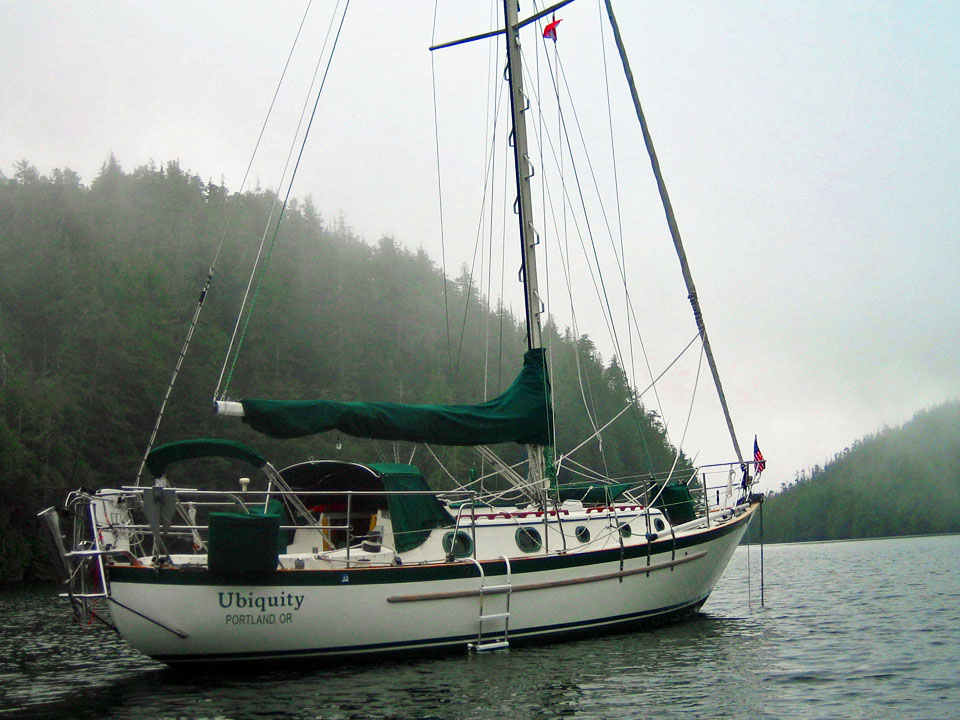
I bought Pacific Seacraft 34 hull #67, built in 1987,
for her offshore cruising design and her good construction quality.
I named her "S/V Ubiquity", with the hope that other cruisers would see her
and say, "There's Ubiquity; she's everywhere!"
Then I worked on and outfitted the boat for my post-retirement cruising plans.
 See my blog,
photos, videos, and where I have cruised my Pacific Seacraft 34.
See my blog,
photos, videos, and where I have cruised my Pacific Seacraft 34.
Design Characteristics of the Pacific Seacraft 34 that I Like for Cruising:
-
Cutter rig provides a flexible sail plan, especially for higher winds.
Some owners put the staysail on a furler,
but another option is a hank-on staysail with a quick-release staysail stay
for quick conversion to a sloop rig.
-
Elongated fin keel underbody
has excellent tracking stability and adequate maneuverability.
The underbody has a slight bridge between the keel and the skeg,
which shifts the design slightly more towards
the traditional side of the full-fin keel continuum (compared, for example,
to the Valiant design).
Aft of the heavily-built skeg the propeller is in an aperture.
The propeller location, in an aperture behind the slight bridge,
protects against entanglements such as crab pots.
-
Seaworthy hull dimensions and design
enhance offshore safety and seakindliness.
The narrower beam compared to more modern cruising designs
reduces interior space and form stability,
but creates a seakindly motion and high ultimate stability,
with a limit of positive stability of 144 degrees.
-
Good ability to heave-to on a mainsail only,
which adds to off-shore safety and flexibility during
difficult weather and sea conditions.
-
Canoe stern aids control in strong following seas,
when as Bill Crealock said your stern will "have to serve as your bow".
-
Side-deck security enhanced by a bulwark,
outboard shrouds, and extra-high lifelines.
-
Good anchor platform with stout bow rollers,
large anchor locker, hawsepipes, deck pipes, horn cleats
with backing plates, good windlass placement,
and good foredeck space and security.
-
Stout opening portlights provide offshore security and ventilation
at anchor and in the marina.
Older Pacific Seacraft models have oval bronze portlights,
whereas newer models have rectangular chrome-plated portlights
incorporating better drainage.
-
Small Size, by today's standards for a cruising boat, still meets my space
and carrying capacity requirements.
A smaller size costs less and is easier to handle,
especially when sailing short-handed or older in age.
-
Aesthetics that I find pleasing.
Pacific Seacraft 34 Reviews and Information:
Specifications (approximate) for Pacific Seacraft 34:
- 13,200 lb. displacement
- 4,800 lb. external lead ballast
- 34' 1" overall length, 26' 3" water-line length
- 10' maximum beam
- 4' 11' fin keel
(5' 0" when loaded for cruising),
4' 1" scheel keel
- 47' total air draft (vertical clearance including 3' VHF antenna)
- 6' 3" interior head room
- 600 sq. ft. sail area (cutter with working jib, staysail)
- 300 sq. ft. wetted surface area
- Tankage: 75 gal. water, 32 gal. diesel (27 gal. sheel keel), 16 gal. holding
- Yanmar 3HM35F diesel engine (1987 model)
- 34 hp 1-hour rating (3400 rpm)
- 30 hp continuous (3200 rpm)
- (Later models have slightly more hp.)
Performance Statistics (approximate) for Pacific Seacraft 34:
- 144 degrees, LPS, limit of positive stability
- 6.9 knot (7.9 mph), hull speed
- 330, D/LWL, displacement to length of water line
- 15-19, SA/D, sail area to displacement, (depends on sail configuration)
- 1.8-2.2, SA/WSA, sail area to wetted surface area, (depends on sail configuration)
- 195-204 PHRF handicap (varies for different racing fleets)
- 1.6, CR, capsize risk
- 33, MC, motion comfort
- .05, RA, roll acceleration
- 3.9, RP, roll period
- 940, P/I, pounds per inch immersion
Sailing Characteristics of the Pacific Seacraft 34:
Below you can see videos showing the Pacific Seacraft 34 sailing in different conditions,
on different points of sail,
with a variety of sail configurations,
and with different types of steering (windvane, autopilot, manual, and locked).
- Beating as cutter, reefed genoa, main outhaul eased,
Sea of Cortez at sunset, 12 kt wind, autopilot steering
- Beating off the Washington coast, sailing as cutter, Yankee sheeted to inside genoa track, winds in mid-20's
- Beating into 25 kt wind, reefed main and headsail, Goletas Channel, north of Port Hardy, British Columbia
- Beating into 30 kt wind, staysail and reefed main, Principe Channel, east of Banks Island, British Columbia
- Beating with staysail and reefed main, Principe Channel, British Columbia, wind now increasing into 30's
- Beating as cutter (jib, staysail, reefed main) Estevan Point on west side of Vancouver Island, wind about 20
- Beating into 15 kt wind, full mainsail and working jib, Johnstone Strait, British Columbia, steering locked
- Beating, full mainsail and jib, but wind now is increasing into the 20's, Johnstone Strait, British Columbia
- Beating into 20 kt wind, crossing the Columbia River Bar, somewhat rough conditions, new sailor excited
- Close reaching, Cabo Falso, Mexico, wind mid-20's, rough seas, reefed main and staysail, windvane steering
- Close reaching, crossing Strait of Juan de Fuca in small craft advisory, reefed main and jib, steering locked
- Close reaching, crossing Strait of Juan de Fuca in small craft advisory, view outside dodger, steering locked
- Close reaching, full jib and reefed main, Off Cape Flattery, Washington coast, 20 kt wind, windvane steering
- Close reaching, full jib and reefed main, Columbia River Bar, moderate conditions, fog, view towards bow
- Close reaching, full jib and reefed main, Columbia River Bar, moderate conditions, view towards helmsman
- Beam reaching, Sea of Cortez, 15 kt wind, mainsail reefed,
strong wind has moderated, windvane steering
- Beam reaching as cutter (jib, staysail, main), Sea of Cortez, 8 kt wind, mild conditions, windvane steering
- Beam reaching, south of Barkley Sound, Vancouver Island, 15 kt wind, beautiful sunshine, mainsail and jib
- Broad reaching,
action camera fisheye view from above, 15-20 kt wind, mainsail and jib, windvane steering
- Broad reaching, Vancouver Island west side, off of Estevan Point, Hesquiat Peninsula, windvane steering
- Broad reaching, Strait of Georgia, Vancouver Island, wind about 20, full main and jib, windvane steering
- Broad reaching, 60 miles off Washington coast in thick fog, 15 kt wind, mainsail and jib, autopilot steering
- Broad reaching, water-level view looking towards bow,
15-20 kt wind, mainsail and jib, windvane steering
- Running with reefed main only, Brooks Pennisula, Vancouver Island, gusting into 30's, windvane steering
- Running with reefed jib only, Cape Mendocino, gusting into 30's, big following seas, windvane steering
- Running with reefed jib only, another view, Cape Mendocino, gusting to 30's, big following seas, wet ride
- Running with staysail only, view fore, Baja coast, gusting to upper 20's, confused seas, windvane steering
- Running with staysail only, view aft, Baja coast, gusting to upper 20's, confused seas, windvane steering
- Running dead downwind with mainsail only, Sea of Cortez, 14 kt wind, mild conditions, autopilot steering
- Running, wing-and-wing, Vancouver Island west side, south of Cape Scott, 20 kt wind, windvane steering
- Running w/spinnaker, Strait of Georgia, Vancouver Island, asymmetric and no mainsail, windvane steering
- Hove-To, off Oregon coast, reefed mainsail only (no backed jib), rudder to windward, winds in lower 20's
My experience has impressed me with the virtues of the Pacific Seacraft 34
as an offshore boat.
She tracks well and can steer to weather with the helm locked,
yet has acceptable maneuverability in the marina.
Her motion in a seaway is easy.
She heaves to on a mainsail (usually reefed) alone.
Whereas more performance-oriented cruisers would prefer a lighter fin keel design,
and more traditionally-oriented cruisers would prefer a heavier full keel design,
for me the Pacific Seacraft 34 occupies the sweet spot for offshore cruising,
especially for an older person cruising with one crew member or perhaps alone.
Heaving-To the Pacific Seacraft 34 on Mainsail Only:
My cruising friend Dave Mancini first alerted me to how well
the Pacific Seacraft 34 design could heave-to using mainsail,
usually reefed, alone (See the link to Dave's web site above,
and also the video above of S/V Ubiquity hove-too on mainsail
alone).
This characteristic saved me after getting hurt trying to
round Cape Blanco off the Oregon coast. In much stronger
conditions than in the hove-to video shown above, the boat
stayed hove-to all night while I lay on the cockpit
sole in my foulies recovering from a head injury.
You can read about that incident
on my sailing blog,
and you can
see my injuries the next day, after on-board first aid.
On the hard, showing her underbody design with elongated fin keel,
slight bridge to the skeg, propeller in an aperature, skeg-hung rudder,
and canoe stern:
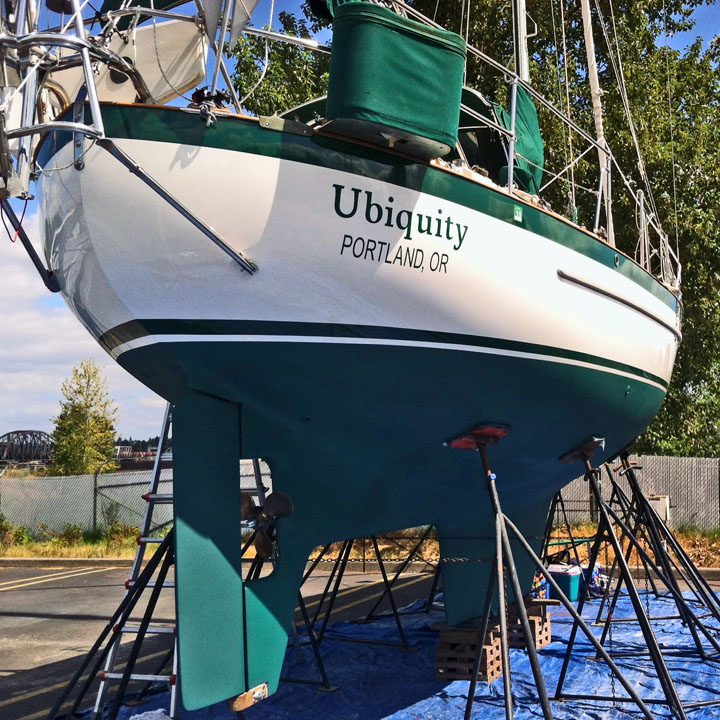
Equipment and Outfitting Details for S/V Ubiquity,
my Pacific Seacraft 34
:
(Many with photos, so click on the links.)
- Sails and Rigging:
- Cruising Sail Inventory:
Her mainsail and her
110% genoa
(her standard cruising headsail) are heavily made by
Taylor Sails
in Port Angeles.
For high winds she has the staysail, two deep reefs in the mainsail, and a
high-clew 55% Yankee that I sheet to the inner genoa track when sailing close
to weather in strong conditions, plus it looks great when sailing
as a cutter with the staysail.
To keep her moving in light air I have a large
asymmetric spinnaker (with dousing sleeve) and a
drifter.
For very strong conditions I carry a
trysail (on a separate track) and a
storm staysail.
When going on a long off-shore passage, or when concerned about possible strong conditions offshore,
I bag the trysail at the base of the mast,
hanked to the trysail track, ready for quick deployment.
- Mainsail Design and Handling:
Counter to current trends,
I decided on a battanless, roachless mainsail.
Eric Taylor of
Taylor Sails in Port Angeles
designed and made the mainsail to my specifications.
Combined with
Tides Marine Sail Track ("Strong Track")
hardware for the luff,
the mainsail hoists and drops very easily.
I eliminated the clutter of the lazy jacks
and instead of flaking the mainsail on top of the boom
I roll it into a bunt and tie it on the side of the boom,
as my experienced cruising friend Dave Mancini,
who sailed a sister ship (S/V Swan) through the South Pacific and Mexico,
taught me.
- Mainsail Reefing:
The two deep reefs reduce the sail area to 65% / 39% of the total area,
from 233 sq. ft. to 152 / 90 sq. ft.
For cruising I prefer two deep reefs to the standard three-reef cruising setup.
I set the tacks using short lines tied at the mast, not hooks.
I set the clews using two reefing lines that terminate in the cockpit.
- Mainsail Preventers:
Since Ubiquity has no aluminum toerail I could use for anchoring a mainsail preventer,
I rigged
a line to one of the chainplates to provide a solid preventer anchor.
When not in use, bungie cords hold the preventer lines.
When in use in offshore conditions, I rig lines from the cockpit,
through the blocks on the preventer anchors, and to the boom.
I tie the preventer lines off on horn cleats I installed just below the gunwale top,
outside face, just aft of the primary winches.
- Headsail Furler:
a Schaefer System 2100 furler I installed myself.
- Staysail:
The staysail is hanked-on and
stowed in a sail bag.
I can convert Ubiquity easily to a sloop rig by releasing the
quick-release on the staysail stay
and stowing the stay using
attachments near the mast.
- Running Rigging:
I converted the headsail and mainsail halyards to internal,
and added an internal boom topping lift / backup main halyard.
I added two
Andersen 12 ST FS winches on the mast
to work the halyards, plus a clutch for the headsail halyard
(I prefer working the halyards and setting the reefing tacks at the mast).
I added an external spinnaker halyard.
The lines I run to the cockpit include the main outhaul,
boomvang, main topping lift, and the two clew reefing lines.
Groups of four clutches,
on each side of the companionway and under the dodger,
plus winches,
serve these five lines plus the three sheets (main sheet, two staysail sheets).
- Standing Rigging:
I replaced all of the standing rigging myself, using
Hayn Hi-Mod terminals at the lower stay terminations
and standard swages at the upper.
Turnbuckles are Hayn,
locked with stainless welding rod (a method I learned from a Brion Toss video).
I followed Dave Mancini's lead and used 9/32" 316 wire, except for 5/16" on the headstay.
Running backstays are 3/16" with block and tackle going to padeyes on the rear sidedeck.
- Anchoring:
- Primary Ground Tackle and Equipment:
Her primary ground tackle is a 44 lb.
Rocna 20 anchor (true weight 47 lbs.) on 207' of 5/16" high-test chain,
with 200' of 5/8" 3-strand nylon that I spliced directly to the chain.
The vertical Muir windlass operates either manually
or electrically. The manual mode using a winch handle works excellently, and I prefer
the exercise of manually retrieving the anchor. I use 1/2" 3-strand nylon for snubbers.
A washdown pump, with a hose connection near the windlass,
allows cleaning of the ground takle
when hauling anchor, helping to keep the anchor locker and bilge clean.
The shackles on all anchors are 7/16" Crosby USA-made alloy shackles, 2.6t WLL rating,
breaking strength rating over 25,000 lbs.
- Stern and Kedge Anchor:
A Fortress FX-16
(10 lb. aluminum Danforth-type anchor with adjustable fluke angle)
stowed on the stern pulpit,
on 20' 5/16" high-test chain and 300' 1/2"
Sampson Super-Strong nylon double-braid
(stowed in the aft anchor locker),
serves as a stern, backup, and kedge anchor.
- Storm Anchor:
A huge Fortress
FX-37, with 8' of chain and 300' of 5/8"
Sampson Super-Strong,
serves as a storm anchor and another backup anchor.
The FX-37 Fortress anchor with the chain attached is in a Stowaway Anchor Bag
in the V-berth ready for quick assembly if needed.
The 300' 5/8" Sampson Super-Strong hawser is quickly accessed via a foredeck pipe for use with
the FX-37 anchor or whenever a strong hawser is needed.
- Anchor Locker:
The aft section of the anchor locker contains the primary rode, with
the chain on the port side of the original
factory-installed locker partition,
and the 3-strand nylon on the starboard side.
To create a forward section in the anchor locker
I added an athwartships partition made of starboard plastic material,
with a retractable net on the top.
This forward section stows the 300' 5/8" double-braid hawser,
quickly available by pulling the hawser onto the foredeck via the starboard foredeck pipe.
Stowing the hawser back in the locker is via the 4" bronze deck plate at the bow,
and requires going below to
help fit the hawser neatly into the forward anchor locker partition.
This photo shows the anchor locker looking forward from the V-berth,
with the chain in the port partition,
the 3-strand in the starboard partition,
and the double-braid hawser in the forward partition behind the netting.
The cam cleats hold the netting tightly in place but allow releasing
the netting when stowing the hawser.
- Riding Sail:
At anchor in windy conditions I usually hoist
a riding sail
on the backstay.
I find the riding sail substantially quiets the boat's movement at anchor.
Ubiquity's riding sail came from
Sailrite,
and is the
20.25 sq. ft. version.
- Steering and Mechanical:
- Self-Steering:
A Monitor windvane steers the boat when sailing and consumes no electricity.
A below-deck hydraulic autopilot steers when motoring and sometimes when sailing.
- Engine:
The Yanmar 3-cylinder diesel engine always starts immediately
(and uses no glow plugs) and serves well as an auxiliary sailboat engine.
Access is excellent either
overhead via the removable cockpit floor hatch, or
in front under the companionway ladder.
The photos show the dual Racor fuel filters with vacuum gauge,
the Groco seawater strainer, and the heavy-duty alternator with dual drive belts.
- Diesel Fuel:
Besides the main fuel tank (marked 30 gal. on my boat),
I carry one 5 gal. fuel container,
stored under the helmsman's seat.
I am against the clutter and weight of multiple 5 gal. fuel containers on the sidedecks,
a common cruiser practice.
Sailing 900 nm from Ensenda, Mexico, south down the Baja coast
past Cabo San Lucas
and then north into the Sea of Cortez to La Paz, Ubiquity needed only 15 gal. of fuel (half a tank)
to top up in La Paz.
So passages like that are possible without extra fuel containers on the sidedecks,
even with a fairly small fuel tank, if you are willing to wait for wind.
Also, running the engine at a low rpm (commonly 1600-1800 for me) conserves fuel.
- Feathering Propeller:
A Luke Feathering 3-Blade Propeller
reduces drag when sailing.
The Luke propeller is not as well-known as the Max-Prop,
but I think is more robustly built and more beautifully crafted.
See
the P.E. Luke Boatyard's on-line information about
this excellent feathering propeller.
- Electronics, Navigation, Communications:
- Nav Table:
The navigation station has a large chart table with storage below,
and with the electronics forward and to the right.
Left to right are the inReach Explorer satellite messenger,
the small Garmin GPSMap 78sc chartplotter that also functions as compass and barograph,
the Raymarine e7d MFD that serves as the main chartpotter and the radar display,
the Garmin GPS 128 Marine Navigator connected to an external antenna.
Above is the high-frequency Icom 706MKIIg radio and Pactor modem,
and below is the Standard Horizon GX-2200 VHF radio with AIS receiver and GPS built-in.
- Binacle/Cockpit Electronics, Instruments:
A remote speaker-mike at the binnacle
provides easy use of the VHF radio, including the AIS receiver, in the cockpit.
A Garmin GPSMap 76c handheld chartplotter in a Ram Mount
is at the helm.
Instruments beside the companionway
display wind, depth, speed, and heading information.
The Ritchie compass at the binnacle has red LED lighting for night use,
switchable below at the electrical panel.
- Viewing Instruments Remotely:
The chartplotter, radar, and AIS transceiver can all be viewed
and controlled not only at the chart table,
but also by iPads/iPhones via Wifi connections,
with the iPads/iPhones secured in
Ram Mounts under the dodger.
- Collision Avoidance:
The digital radar is good enough to see small craft, like pangas in Mexico, and even spot
floats for lobster pots (on smooth seas), in low-visibility conditions.
But the main collision-avoidance aid is AIS.
There are two AIS receivers: the
VHF DSC marine radio with an AIS receiver built-in,
and an AIS transceiver
(Vespermarine Watchmate XB-8000,
mounted far aft in the port cockpit locker).
The VHF radio has its own small AIS display,
and has collision alarms I can set.
The AIS transceiver I turn on when I want to transmit my position;
plus I can use an iPad or iPhone to
display target information from the Watchmate transceiver.
The transceiver has its own
AIS-frequency-tuned antenna on the stern pulpit,
and its own external GPS antenna.
I can also feed either the AIS receiver signal from the VHF radio, or from the AIS transceiver,
to the main Raymarine chartplotter (MFD),
using a DPDT switch:
- When both the AIS transceiver and the chartplotter are on,
I switch the feed to the transceiver,
whichs avoids a problem of the vessel's own AIS target
chasing the vessel and setting off the collision alarm on the chartplotter.
- When the AIS transceiver is off (most of the time during the day),
because I am conserving electrical power when sailing in clear conditions,
and the chartplotter is on, then I switch the AIS feed to the radio.
- When the the chartplotter is off (most of the time sailing offshore),
the switch position does not matter.
However, since I always have the VHF radio on, the radio's AIS target display and the
radio's AIS alarms still work.
- Navigation:
Multiple GPS units provide redundant position fix capability.
Five GPS units at the nav table, one at the binacle,
and one in the port cockpit locker (connected to the AIS transceiver)
operate off of the boat's 12v electrical system.
Several other handheld marine GPS units, iPhones running navigation apps,
iPads running navigation apps and connected via bluetooth to an external GPS
(usually the inReach Explorer, but a Badelf GPS is also available),
and laptop computers connnected to a sensor GPS and running navigation programs,
provide more GPS redundancy.
A sextant, electronic nautical almanac tables,
and sight reduction apps/programs provide non-GPS backup.
Besides electronic charts, S/V Ubiquity carries chartbooks and some paper charts.
- Depth Sounders, Dual:
Because monitoring water depth is important for a cruising boat,
S/V Ubiquity has two independent depth sounders.
The original depth sounder is a
Raymarine ST60+ display beside the companionway,
using a throughhull transducer below the quarterberth.
I added a shoot-through-the-hull transducer near the bow
forward of the keel, and that transducer is driven by and displayed on
the Raymarine e7d MFD,
which can mirror the display also to an
iPhone or iPad in the cockpit.
The shoot-through-the-hull transducer works excellently.
Having two depth sounders adds redundancy,
plus the position of one near the bow
and another near the stern allows quick detection of a depth gradient.
- Satellite Messenger:
The inReach Explorer Satellite Messenger has world-wide coverage and provides
1) tracking capability,
2) two-way text messaging,
3) marine weather forecasts,
and 4) emergency distress capability separate from the emergency EPIRB system.
- High-Frequency Radio:
A
high-frequency ham radio and a Pactor modem at the nav station
provide for long-distance communications, email, and weather information.
For the HF ground/counterpoise I use a
KISS-SSB,
which works well and I removed
all the old corroding copper ribbon,
the grounding plate,
and patched the holes in the hull.
The backstay has an upper Hayn insulator and serves as the HF antenna.
I got rid of the lower insulator and connected the GO-15 wire
from the antenna tuner to the chainplate inside the stern locker,
a more positive connection less subject to corrosion
than the common method of clamping the GO-15 to the backstay.
This does require awareness not to touch the backstay when transmitting.
- Emergency Communications:
Emergency communications capability includes
1) digital distress and voice mayday calls via the VHF marine radio (when within VHF range),
2) EPIRB distress alert via a
ACR GlobalFix iPro EPIRB
which is wired to recive a GPS position
from the VHF radio and therefore will send a position immediately upon activation,
3) emergency distress alert via the inReach Explorer Satellite Messenger,
and 4) HF radio voice mayday calls.
Both the VHF and HF radios were critical in
responding to a Mayday call in 2017 from a
sinking boat on the Sea of Cortez.
- Electrical:
- Electrical Production:
Two 50W
flexible solar panels are sewn in and removable by zippers on each side of the dodger,
with a cover that zips over the panels
for protection when not in use.
Two separate MPPT solar controllers
promote maximum output from each solar panel.
When more solar power is desired, a
compact 40W fold-up solar panel
is available to unfold, orient carefully towards the sun,
and charge the batteries through a MPPT controller that connects to the panel
and plugs into a 12v cockpit outlet.
A Powerline 160A alternator, with dual drive belts and a
Balmer Max Charge 3-stage voltage regulator,
charges the batteries when the engine is running.
A Xantrex Truecharge 2 20A 3-stage battery charger
provides 12V power and charges the batteries when at the dock.
- Battery Storage:
Battery bank is 3 Lifeline GPL-31XT AGM batteries,
125AH rating each, total 375 AH battery capacity.
Blue Sea MRBF Terminal Fuse Blocks
at the positive battery terminals fuse-protect all wiring from the batteries.
I always keep the battery selector switch in the combined (All/1+2/Both) position,
to minimize percent draw-down of any battery bank, and I seldom draw down more than
about 20-30% capacity.
I feel no need for a dedicated starter battery.
- Galvanic Corrosion Protection:
I installed a Yandini Galvanic Isolator
on the shorepower inlet.
In addition to the
propeller nut zinc I use a 1-inch donut zinc on the propeller shaft
to protect the propeller.
Originally the rudder gudgeon had one teardrop zinc but I installed
a second zinc on the other side and upgraded the size.
In marinas I use a "fish", a zinc hung over the side into the water,
and connect the wire from the zinc to the steering wheel
(I tested and found electrical continuity between the wheel, the propeller, and the gudgeon)
to lesson sacrifice of the material on the propeller and gudgeon zincs.
I often use Tef-Gel when installing parts, especially for stainless-aluminum contact
like stainless screws going into aluminum,
and sometimes use Lanicote (mainly for lubrication).
- Lighting:
All lighting, interior and exterior, is LED to minimize electrical use.
Red interior LED lighting is used under way at night.
A masthead tricolor light is used sailing offshore at night.
An LED strobe light is at the masthead for emergency use.
- Water and Plumbing:
- Bilge Access:
I was not happy with the bilge access (Later model Pacific Seacraft 34's had a better
placement for the access opening).
To improve access to the bilge
I had shipwright Eric Bert in Port Angeles build an
extra-large bilge access opening in the cabin sole,
exactly matching the style of the other panels.
This photo shows the access to the bilge using the new access opening:
you can see the upper pump (Lower pump is hidden under upper pump),
the upper and the lower bilge pump switches
(Lower float switch in photo I replaced with an electronic switch),
and the manual pump intake.
- Bilge Pumps, Electric:
An 800 GPH electric pump is at the bottom of the bilge and operated originally by a float switch.
I replaced the float switch with a Water Witch electronic switch, which I find works more reliably.
Part way up the bilge is a 2000 GPH electric pump operated by a float switch,
with an audible alarm that sounds when operating.
- Bilge Pump, Manual:
The original Whale Gusher pump,
because of its horizonal orientation and size,
intruded substantially into the port cockpit locker.
This locker is the only deep locker in the cockpit,
and I wanted to make maximum use of that locker to store large objects.
I therefore replaced the original pump with a Whale Compact 50 pump.
Although the new pump has somewhat lower pumping capacity than the original pump,
it is still a fine pump, and with its
vertical orientation it intrudes much less into the locker.
- Washdown Pump:
A 6 gpm 70 psi washdown pump
(installed in the head underneath the sink)
provides pressure seawater to a
hose connection near the windlass
(I installed the connection under the cover of one of the deck pipes that I did not use),
allowing easy cleaning of the ground tackle and hosing down the side decks.
- Water Inside:
2 spigots, operated by foot pumps or hand pumps,
provide both fresh water and saltwater at both the galley and the head sinks.
Pressure freshwater is available at both sinks also, used mainly when flushing the water tanks.
Seawater for the sinks, toilet, washdown pump,
and watermaker goes through easily accessible and serviceable water strainers.
Seawater for the watermaker goes through a 30 micron filter after going through the strainer.
Fresh water pumped through the spigot at the galley sink goes through either
a 30 micron filter or a carbon filter.
Here is the view below the galley sink showing the seawater strainer
for the sinks and watermaker, and the filter for the fresh water at the galley sink.
- Watermaker:
A Pur (now Katadyn)
PowerSurvivor 40E watermaker
produces water from seawater when cruising extensively in dry cruising locales,
such as the Sea of Cortez.
See Gary Alber's website
for the best information on these watermakers.
The watermaker is
installed below the quarterberth,
just aft of the nav station,
and is easily accessible by flipping up the top part of the quarterberth cushion.
- Water Tank Gauge:
I built a
simple gauge for the stern water tank using a piece of clear vinyl hose with valves at both ends
.
The gauge is conveniently located beside the watermaker,
which can pump water directly to the stern tank if desired.
I prefer the simplicity and elegance of this simple gauge over electronic gauges using sensors.
- Holding Tank:
Integral fiberglass tank can be emptied by a deck pumpout
or by discharge overboard using a manual overboard pump.
- Comfort and Convenience:
- Ventilation:
Besides the two main hatches,
the 10 bronze portlights
all open and have removable bronze screens.
Unless needed for insects, I do not use the portlight screens and airflow is higher.
Ubiquity was made with 2 cowl vents on top of aluminum dorade boxes,
fitted with Ventus clamshell vents.
I find that the cowl vents interfere with the staysail sheets
so I removed the cowl vents.
I fitted
wide-mesh plastic screens in the tops of the dorade boxes,
removed the fine insect screens in the mushroom vents to increase airflow,
and repaired the mushroom vents to full working order.
For ventilation in the aft cockpit locker, where I store fenders and lines that sometimes get wet,
I added a Ventus UFO vent.
Inside Ubiquity 3
electric fans
are available to increase airflow when desired in hot environments.
- Cabin Heater:
A Dickinson Newport Propane heater
works excellently and is an appreciated luxury when sailing in cold and wet weather.
Sometimes underway at night I keep watch sitting at the top of the companionway
with the heater on below,
and besides adding heat the yellow flame provides the ambience of a campfire.
- Lifelines Beside Primary Winches:
I found that the lifelines beside the primary winches sometimes interferred
with the movement of the winch handle.
I fixed the problem by having a
second attachment point welded to the stanchions
several inches below the original attachment point.
Using pelican hooks I can terminate the lifelines either at the original
termination point or at the new, lower point.
I find that I keep the lifelines always at the lower point,
since that keeps the lifelines out of the way of the winch handles.
- Mast Steps:
Mast steps make ascending the mast SO much easier and quicker.
I find I go aloft more often, rather than putting it off.
They have the disadvantage of sometimes entangling lines
(mainly a problem when sailing downwind)
and adding windage and weight aloft.
- Safety:
- Side-Deck Security:
In addition to the bulwark, outboard shrouds, and extra-high lifelines,
extra-heavy 1/4" 1x19 stainless steel wire lifelines add to Ubiquity's side-deck security.
Also, the stern pulpit is modified with added tubing to extend the
top pulpit rail further forward to the gate stanchion.
- Jacklines:
I set up jacklines so that clipped in I can not fall off of the deck.
This requires setting the jacklines near the center of the boat, not on the sidedecks
(e.g. from bow cleat to stern cleat as some books show).
Currently I use
5/8" 3-strand lines running from the dodger to the staysail stay,
and with two tethers I can keep clipped in with one when moving by where the jacklines
are secured to the mast.
I often grab these jacklines when traversing the sidedeck,
when I want to hold something more inboard than the handrails.
- Drogues:
To handle heavy weather S/V Ubiquity carries two drogues:
1) a Galerider Drogue and 2) a Jordan Series Drogue.
- Propane Storage:
The propane locker is external,
hung off of the stern pulpit,
which I prefer for safety to an internal vented locker.
Here is information about this propane locker
from the October 1988 Cruising World.
Propane is switched on at the main electric panel,
opening a solenoid valve at the tanks.
I installed a big red LED warning light,
which is on whenever the propane is on, on the panel beside the switch.
- Liferaft:
An inflatable liferaft came with the boat,
and in 2016 I replaced the 1998 liferaft with a new Viking liferaft,
stored in a hard canister forward of the mast.
Two snap shackles release the straps holding the canister with quick pulls on the shackle lanyards.
A white (to keep cool in sunlight) sunbrella cover
protects the cannister and straps,
and stays securely in position but is easy to pull off.
Frankly, I question how much a liferaft aboard increases safety,
since launching and getting into the raft in serious offshore conditions
seems unlikely and could distract from saving the boat.
Nonetheless, in a scenario like hitting a whale
in calm conditions, deploying a liferaft would likely succeed.
- Survival Suits:
S/V Ubiquity carries
two survival suits, bright red/orange with strobe lights.
- Lightning Protection:
At the masthead is a
Forespar Lightning Master Static Dissipator,
a device that attempts to reduce the chance of lightning strike
by dissipating the build-up of static ground charge.
Welding cable connects the base of the mast
to a keel bolt,
creating a path in the event of a strike for the electricity
to discharge from the external lead keel.
- Hull and Topsides Aesthetics:
- Hull Paint:
The hull was painted dark green and needed re-painting when I purchased the boat.
I had Platypus Marine
in Port Angeles, Washington, paint the hull white,
a cooler color for hot environments, using Awlgrip Stark White.
Platypus has facilities for huge boats,
and was able to paint Ubiquity indoors without removing the mast.
- Hull Stripes:
The upper hull stripe I had re-painted the full length of the hull,
which I like better than the original Pacific Seacraft upper stripe
that terminates before the bow and the stern.
The upper and lower hull stripes are Awlgrip Forest Green, which match the canvas.
- Handrails on Cabin Top:
The teak handrails
are especially hard to keep looking nice with varnish or Cetol.
Following the lead of Dave Mancini (S/V Swan) I painted them with Pettit Easypoxy Brightwork Brown.
I used Cetol as the undercoat/primer, which would make it fairly easy to remove using a heat gun.
Dave found that after four years in the tropics they still looked great,
whereas Cetol lasted maybe a month.
- Teak Cabin "Eyebrows":
The teak eyebrow stripes over the cabin portlights
I painted with Pettit Easypoxy Jade Green, which blends nicely with the hull stripes
and the green patina of the bronze portlights.
- Teak Rub Rails:
The
teak rub rails I treat about yearly with a light-grey latex solid stain.
My goal is to protect the teak and achieve approximately the grey weathered teak look.
The stain wipes on very easily, and lasts pretty well. When I apply it I mask with
blue masking tape to avoid getting stain on the hull.
- Teak Toe Rails:
I maintain the toe rails using Semco Goldtone Teak Sealer.
I like the natural look of the Semco,
and it provides an excellent surface for stepping when getting off the boat.
Varnish and Cetol make a slippier surface, and are much harder to maintain and remove.
- Equipment that I Removed:
- Refrigeration:
I removed the refrigeration unit and gave it to a friend.
This greatly reduces electrical consumption and frees up storage space.
I have found that ice (block with crushed) lasts us to 2 weeks or more in the well-insulated cooler,
and cruising in the Pacific Northwest and even in Mexico I always have ice.
See Beth Leonard's The Voyager's Handbook
for how you can cruise without refrigeration.
- Hot Water Tank:
I removed the hot water tank and gave it to a friend.
This got the tank and the associated hoses out of the way when working on the mechanics
(The old hot water tank blocked access to the steering quadrant).
A Sunshower, plus hot water from the stove, serve as hot water sources for washing on S/V Ubiquity.
- Shower in the Head:
I removed the factory-installed shower in the head
because I don't like getting the head all wet by taking a shower in the head,
and prefer taking a shower in the cockpit with the Sunshower.
- Cooler Drain Pump:
The cooler drain pump did not work well and was in the way in the engine compartment.
I removed the pump and routed the cooler drain hose directly to the bilge.
I placed a screen over the drain entrance in the cooler.
Now there is never any water build-up in the cooler
and engine access on the port side is less obstructed.
- Cowl Vents:
The staysail sheets tended to catch on the cowl vents.
I removed the cowl vents and placed
loose-weave heavy plastic screen
over the openings of the round dorade boxes.
There is still a lot of ventilation through the dorage boxes when the mushroom vents are open.
At anchor or at the marina one could put on the cowl vents for more ventilation,
but I do not bother since I find that opening the
hatches and portlights provides a lot more ventilation anyway.
- Lazy Jacks:
The battanless mainsail design and Strong Track hardware
made dropping the mainsail easy,
and I was able to remove the lazy jacks and eliminate that clutter.
As explained above, I stowe the mainsail by quickly rolling it into a bunt
lashed to the side of the boom,
rather than flaking the mainsail on top of the boom.
Since a cutter rig has plenty of extra lines already (staysail sheets and
halyard, running backs) removing the lazy jack clutter was welcome.
Big following seas rushing by south of Cape Mendocino:
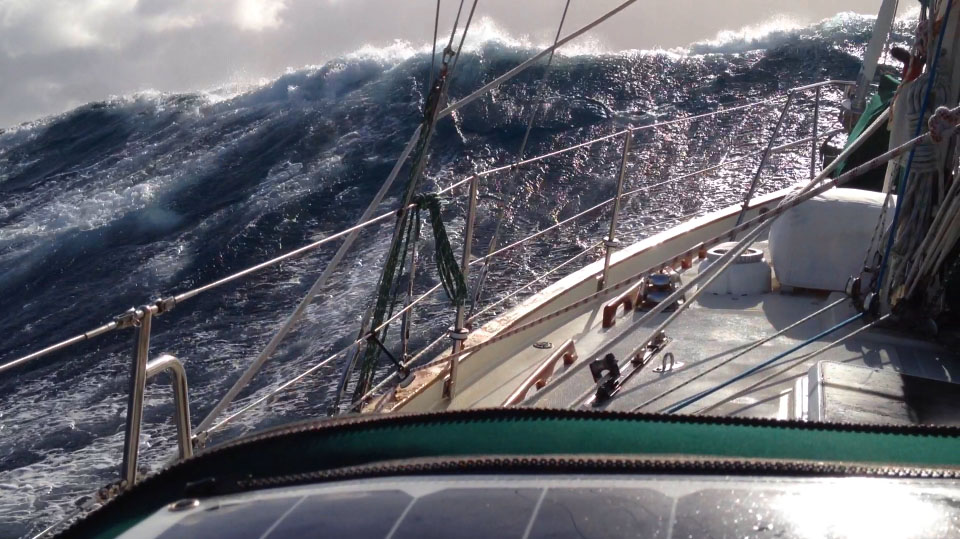
Sailing as cutter at sunset, Sea of Cortez, Mexico:
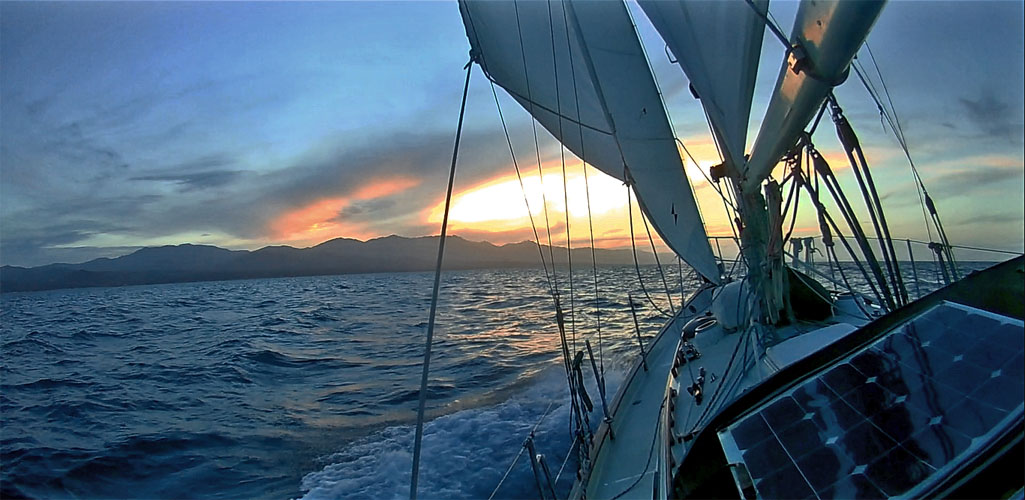
Sailing on the Columbia River in light winds:
Sailing on the Columbia River for a meetup introduction to sailing class outing:
Flying asymmetric spinnaker (left), and beating (right)
in very light air with the drifter on the Columbia River, sailing class outing:
Two photos (on left) show S/V Ubiquity sailing off Port Angeles
before she received her new white paint job
(Photos taken by my friend Dave Mancini, sailing his sister ship, S/V Swan).
Photo (on right) shows S/V Ubiquity at the dock with Yankee and staysail hoisted:
Sailing as a cutter off the Washington coast,
beating into winds in the 20's, Yankee headsail
sheeted to inside track, toerail in the water:
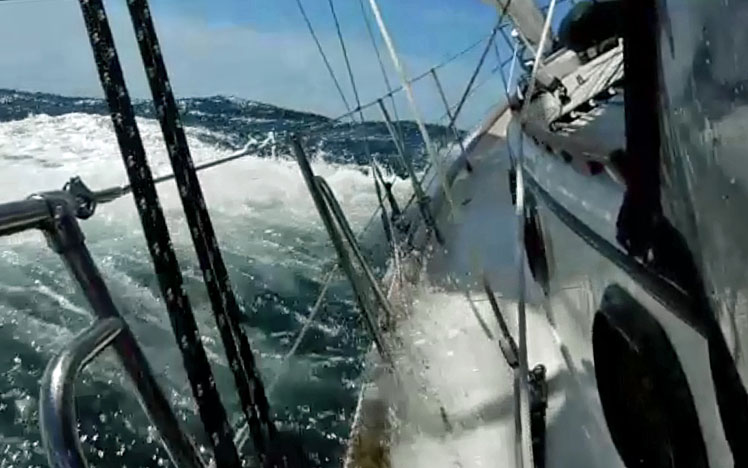
At anchor, Isla San Cosme, north of Aqua Verde,
Sea of Cortez, Mexico:
